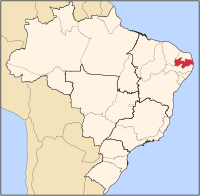Paraíba
| ||
| Flag of Paraíba | ||

| ||
| See other Brazilian States | ||
| Capital | João Pessoa | |
| Largest City | João Pessoa | |
| Area | 56.439,8 km² | |
| Population - Total - Density |
3.595.886 63,7 inh./km² | |
| Governor | Cassio Cunha Lima(PSDB) | |
| Demonym | Paraibano | |
| HDI (2000) | 0.661 – medium | |
| Timezone | GMT-3 | |
| ISO 3166-2 | BR-PB | |
Paraíba (pron. IPA: [pa.ɾa.'i.ba] [1]) is one of the states of Brazil, located in the northeastern part of the country, on the Atlantic coast. It contains the easternmost land of the Americas.
History
In the mid-1500s, Portuguese settlers from Pernambuco founded Filipéia de Nossa Senhora das Neves (today João Pessoa) at the mouth of the Paraíba do Norte River.
The area soon proved perfect for sugar production, with the French, the Dutch and the Portuguese all constantly fighting to control the Paraíba region to grow the lucrative sugarcane in. The fortress of Santa Catarina, near João Pessoa, was built to protect the city from the Dutch, who soon became a threat to Portuguese supremacy in Brazil.
In late 1989 a team led by gemstone prospector Heitor Dimas Barbosa uncovered in a small mountain range what some consider to be the finest Tourmaline crystals ever found. A trace of copper gives the tourmalines a vivid turquoise color that had never been seen before in the gems.
The "neon" paraiba tourmaline, a vivid blue and blue green, has also been found in other deposits close to the Batalha mine of Barbosa, and also in the neighboring state of Rio Grande do Norte. The bright colors of this tourmaline are due to the presence of copper. Around 2000, a similar copper-containing tourmaline was found in Nigeria, although the colors are not as intense. Around 2004, beautiful crystals of copper-containing tourmaline were found in Mozambique.
Initially the nomenclature for this tourmaline was "Paraíba tourmaline". Note the capitalization and the accent on the "i". In 2006, the LMHC (Laboratory Manual Harmonization Committee) agreed that "paraiba" should refer to a species of tourmaline, and indicate a geographic origin. Note "paraiba" is not capitalized, and does not have an accent on the "i". For more information on paraiba tourmaline, see article on tourmaline.
Economy
The Paraíba economy is largely based upon three items: the making of shoes and other leather products, the raising of cattle for beef, and sugarcane. Though historically sugarcane has dominated the Paraíba agricultural sector, pineapple cultivation is also widespread.
Flag
The word négo is Portuguese for "I deny", referring to the protests that erupted in the 1920s in Paraíba, supported by state president João Pessoa, to the appointment of Júlio Prestes as the President of Brazil. João Pessoa joined the alliance for the overthrow of the federal government, which successfully conducted Getúlio Vargas to Presidency. The rebellion eventually lead to the murder of João Pessoa.
According to the official government site of the state of Paraíba, the red stands for the blood due to the assassination of João Pessoa; the black represents the mourning following the assassination. Some associate the colors with communism and anarchism, but this interpretation does not find echoes in Paraíba's history.
Major Cities
- Joao Pessoa, state capital
- Campina Grande
- Patos
- Sousa
- Guarabira
- Areia
See also:
- List of cities in Brazil (all cities and municipalities)
Notes
- ^ The presented pronunciation is in Brazilian Portuguese. The European Portuguese pronunciation is: /pɐ.ɾɐ.'i.βɐ/.
External links
- Photos of the state from an official governmental website

